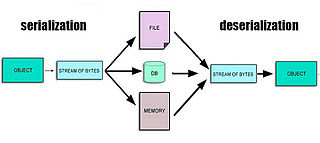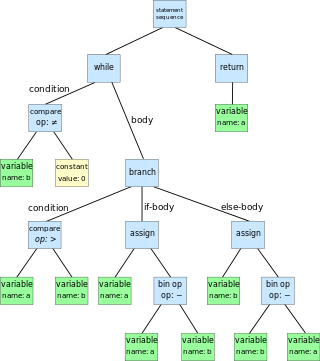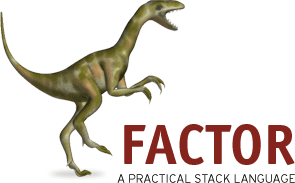Related Research Articles
In computing, a compiler is a computer program that translates computer code written in one programming language into another language. The name "compiler" is primarily used for programs that translate source code from a high-level programming language to a low-level programming language to create an executable program.

A programming language is a system of notation for writing computer programs. Programming languages are described in terms of their syntax (form) and semantics (meaning), usually defined by a formal language. Languages usually provide features such as a type system, variables, and mechanisms for error handling. An implementation of a programming language is required in order to execute programs, namely an interpreter or a compiler. An interpreter directly executes the source code, while a compiler produces an executable program.

Perl is a high-level, general-purpose, interpreted, dynamic programming language. Though Perl is not officially an acronym, there are various backronyms in use, including "Practical Extraction and Reporting Language".

In computing, serialization is the process of translating a data structure or object state into a format that can be stored or transmitted and reconstructed later. When the resulting series of bits is reread according to the serialization format, it can be used to create a semantically identical clone of the original object. For many complex objects, such as those that make extensive use of references, this process is not straightforward. Serialization of objects does not include any of their associated methods with which they were previously linked.

Extensible Markup Language (XML) is a markup language and file format for storing, transmitting, and reconstructing data. It defines a set of rules for encoding documents in a format that is both human-readable and machine-readable. The World Wide Web Consortium's XML 1.0 Specification of 1998 and several other related specifications—all of them free open standards—define XML.
XSLT is a language originally designed for transforming XML documents into other XML documents, or other formats such as HTML for web pages, plain text, or XSL Formatting Objects. These formats can be subsequently converted to formats such as PDF, PostScript, and PNG. Support for JSON and plain-text transformation was added in later updates to the XSLT 1.0 specification.
Jakarta Server Pages is a collection of technologies that helps software developers create dynamically generated web pages based on HTML, XML, SOAP, or other document types. Released in 1999 by Sun Microsystems, JSP is similar to PHP and ASP, but uses the Java programming language.

In computer science, an interpreter is a computer program that directly executes instructions written in a programming or scripting language, without requiring them previously to have been compiled into a machine language program. An interpreter generally uses one of the following strategies for program execution:
- Parse the source code and perform its behavior directly;
- Translate source code into some efficient intermediate representation or object code and immediately execute that;
- Explicitly execute stored precompiled bytecode made by a compiler and matched with the interpreter's virtual machine.

An abstract syntax tree (AST) is a data structure used in computer science to represent the structure of a program or code snippet. It is a tree representation of the abstract syntactic structure of text written in a formal language. Each node of the tree denotes a construct occurring in the text. It is sometimes called just a syntax tree.
Bytecode is a form of instruction set designed for efficient execution by a software interpreter. Unlike human-readable source code, bytecodes are compact numeric codes, constants, and references that encode the result of compiler parsing and performing semantic analysis of things like type, scope, and nesting depths of program objects.
Metaprogramming is a computer programming technique in which computer programs have the ability to treat other programs as their data. It means that a program can be designed to read, generate, analyse, or transform other programs, and even modify itself, while running. In some cases, this allows programmers to minimize the number of lines of code to express a solution, in turn reducing development time. It also allows programs more flexibility to efficiently handle new situations with no recompiling.

Apache Groovy is a Java-syntax-compatible object-oriented programming language for the Java platform. It is both a static and dynamic language with features similar to those of Python, Ruby, and Smalltalk. It can be used as both a programming language and a scripting language for the Java Platform, is compiled to Java virtual machine (JVM) bytecode, and interoperates seamlessly with other Java code and libraries. Groovy uses a curly-bracket syntax similar to Java's. Groovy supports closures, multiline strings, and expressions embedded in strings. Much of Groovy's power lies in its AST transformations, triggered through annotations.
A domain-specific language (DSL) is a computer language specialized to a particular application domain. This is in contrast to a general-purpose language (GPL), which is broadly applicable across domains. There are a wide variety of DSLs, ranging from widely used languages for common domains, such as HTML for web pages, down to languages used by only one or a few pieces of software, such as MUSH soft code. DSLs can be further subdivided by the kind of language, and include domain-specific markup languages, domain-specific modeling languages, and domain-specific programming languages. Special-purpose computer languages have always existed in the computer age, but the term "domain-specific language" has become more popular due to the rise of domain-specific modeling. Simpler DSLs, particularly ones used by a single application, are sometimes informally called mini-languages.
The Simplified Wrapper and Interface Generator (SWIG) is an open-source software tool used to connect computer programs or libraries written in C or C++ with scripting languages such as Lua, Perl, PHP, Python, R, Ruby, Tcl, and other language implementations like C#, Java, JavaScript, Go, D, OCaml, Octave, Scilab and Scheme. Output can also be in the form of XML.
In some programming languages, eval, short for evaluate, is a function which evaluates a string as though it were an expression in the language, and returns a result; in others, it executes multiple lines of code as though they had been included instead of the line including the eval. The input to eval is not necessarily a string; it may be structured representation of code, such as an abstract syntax tree, or of special type such as code. The analog for a statement is exec, which executes a string as if it were a statement; in some languages, such as Python, both are present, while in other languages only one of either eval or exec is.

Factor is a stack-oriented programming language created by Slava Pestov. Factor is dynamically typed and has automatic memory management, as well as powerful metaprogramming features. The language has a single implementation featuring a self-hosted optimizing compiler and an interactive development environment. The Factor distribution includes a large standard library.
Bigloo is a programming language, an implementation of the language Scheme, a dialect of the language Lisp. It is developed at the French IT research institute French Institute for Research in Computer Science and Automation (INRIA). It is oriented toward providing tools for effective and diverse code generation that can match the performance of hand-written C or C++. The Bigloo system contains a Scheme compiler that can generate C code and Java virtual machine (JVM) or .NET Framework (.NET) bytecode. As with other Lisp dialects, it contains an interpreter, also termed a read-eval-print loop (REPL). It is free and open-source software. The run-time system and libraries are released under a GNU Lesser General Public License (LGPL). The compiler and programming tools are released under a GNU General Public License (GPL).

A template processor is software designed to combine templates with data to produce resulting documents or programs. The language that the templates are written in is known as a template language or templating language. For purposes of this article, a result document is any kind of formatted output, including documents, web pages, or source code, either in whole or in fragments. A template engine is ordinarily included as a part of a web template system or application framework, and may be used also as a preprocessor or filter.
Seed7 is an extensible general-purpose programming language designed by Thomas Mertes. It is syntactically similar to Pascal and Ada. Along with many other features, it provides an extension mechanism. Seed7 supports introducing new syntax elements and their semantics into the language, and allows new language constructs to be defined and written in Seed7. For example, programmers can introduce syntax and semantics of new statements and user defined operator symbols. The implementation of Seed7 differs significantly from that of languages with hard-coded syntax and semantics.
References
- ↑ Hunter, Jason; Crawford, William (April 3, 2001). Java Servlet Programming: Help for Server Side Java Developers . "O'Reilly Media, Inc.". p. 423. ISBN 9780596000400 – via Internet Archive.
tea programming language.
- ↑ Huynh, Khue; Razzaq, Leena (January 1, 2002). "A Distance learning system for Tea programming". Major Qualifying Projects (All Years).
- ↑ TeaClipse